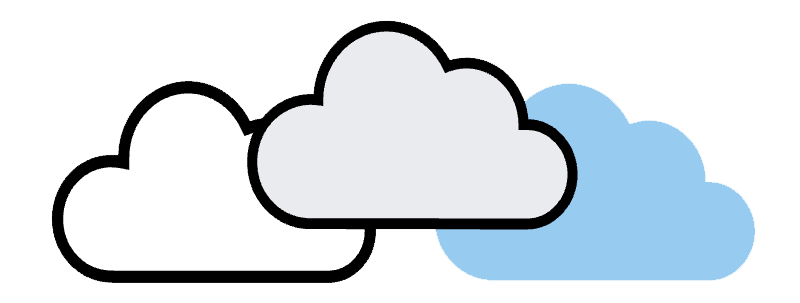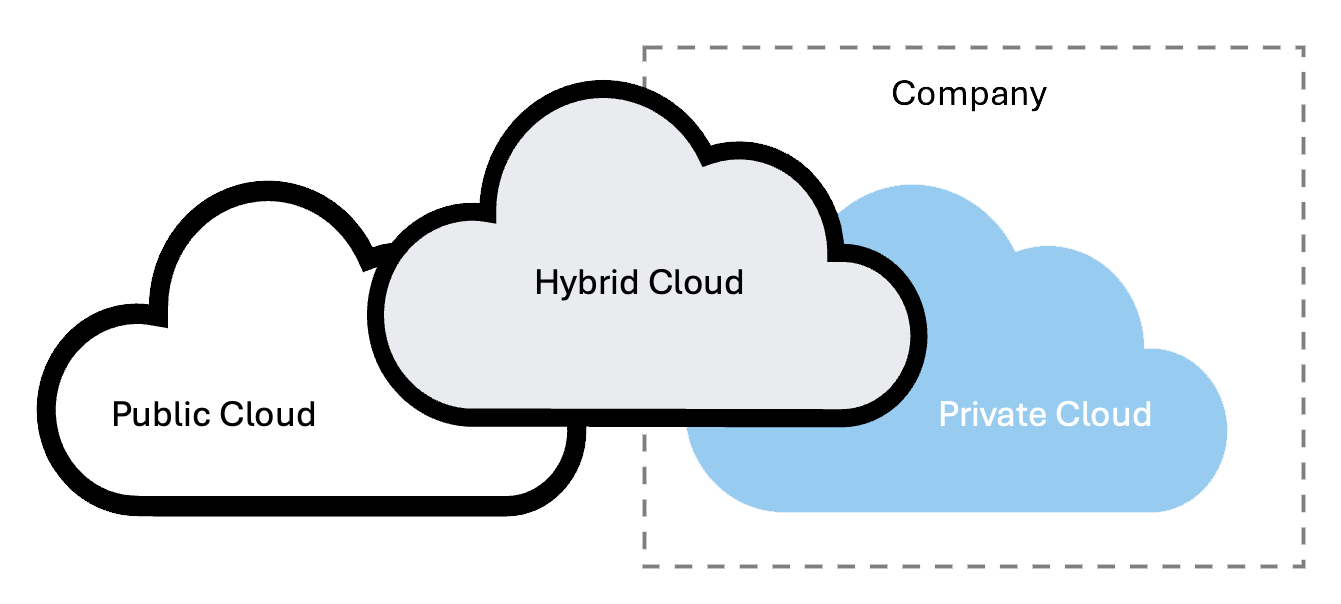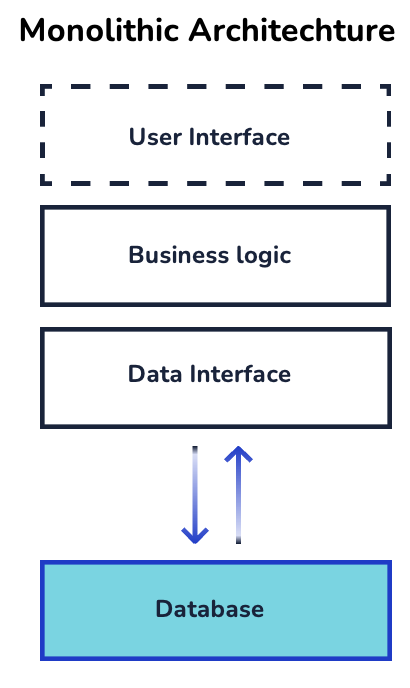Cloud Solutions
Tricloud offers many different services for building software within Cloud Computing. We can help you design, build and operate any cloud solution. Whether the solution is small or scaled for large enterprises.

Enterprise Solutions
An enterprise solution is a platform that must ultimately provide all the resources needed to perform the required business functions. The business requirements must be implemented within the architecture of the framework.
Private, Public, or Hybrid
An enterprise solution can either be hosted and maintained in the on-premises datacenter of the organization (private cloud), or in a public cloud. Sometimes an enterprise platform is hosted and maintained in a hybrid setup, where some services are running on-premises and some are running in the public cloud. In any case, the end goal of any enterprise cloud solution is to provide the necessary tools to manage or support a specific set of business functions, systems or resources.

Integrations & Active Directory
In any cloud solution, we often experience, that there is a need for integrations between services in the cloud solution and existing services, systems, or resources already owned by the organization. We have experience in implementing such integrations, as well as integrating the solution with the on premises Active Directory using Azure AD. The identity management gets simplified, as users of the platform can utilize Single Sign On (SSO), meaning users only need to identify themselves using their existing organizational account, in order to gain access to all resources the platform provides. In enterprise solutions, Tricloud can provide Azure AD integration to seamlessly enable SSO for enterprise customers.
API Management
APIs makes enterprise data reachable, whether its data used in organizational Apps or other systems. API management is a layer that adds the ability to manage the access that the APIs expose in a secure manner, whether the data is used by customers, employees or partners.
A key reason why any company would consider API management is to secure their APIs. This is not just about authenticating and authorizing access to APIs, it is also about policies to block attacks, ensure sensitive data is not accidentally or intentionally leaked and in rare cases to revoke access granted by integrating systems or users.
Other reasons to use API management, could be in scenarios where data or schemas needs transformation to match a certain integration requirement, or response data should be combined from several backend systems.
Tricloud can implement cloud solutions with Azure API Management to accelerate our customers growth and streamline how access is granted and maintained across hybrid and multi-cloud environments.
Microservices
Microservice based architecture has gained increasing popularity during the last several years, especially in enterprise solutions. The reason for this acclaim is that microservices can solve many challenges such as handling a large code base, adopting a new technology, scaling, deployment, and implementing new changes. In contrast to the traditional monolithic approach in writing software, microservices offers a self-contained piece of business functionality with clear interfaces and can implement its own layered architecture. The benefit of decomposing a system into different smaller services are numerous:
- Modularity: This makes the system easier to understand, develop, test, and become more resilient to architecture erosion. This benefit is often argued in comparison to the complexity of monolithic architectures.
- Scalability: Since microservices are implemented and deployed independently of each other, i.e. they run within independent processes, they can be monitored and scaled independently.
- Migration: Microservices are considered a viable mean for modernizing existing monolithic software applications. The process of migrating legacy systems is done using an incremental approach.
- Autonomy: Microservices helps bring autonomy to distributed development, enabling small independent teams to develop, deploy, and scale their respective services. Microservice-based architectures facilitate continuous delivery and deployment.
- Resiliency & Robustness: Each microservice can be hosted in multiple instances for improved performance and robustness. Faulty services do not necessarily impact one another.
Adopting a microservices architecture is not a one-size-fits-all approach. Despite being less and less popular, a monolith has its strong and durable advantages which works better for many use cases. For instance, if your business idea is fresh and you want to validate it, it may be a good idea to start with a monolith.

Microservice platforms
If your organization does not have microservice expertise, you might want to use a partner with hands-on experience in building a microservice architecture. Tricloud has experience in designing, implementing, and operating microservice-based platforms, and we are able to assist you on your journey.
Choosing the microservice architecture means you must choose a platform for hosting the microservices. In recent years Kubernetes has gained increased popularity, which allows scaling and deployment using Docker containers. It is an open source framework, that can be deployed and hosted either in the cloud or in on-premises datacenters. Microsoft also offers a platform for microservices called Service Fabric. Service Fabric provides comprehensive runtime and lifecycle management capabilities to applications.
Operating and maintaining Kubernetes or Service Fabric is not a trivial task. It requires highly skilled personnel to keep platforms as well as servers up to date. These types of platforms require capacity planning, monitoring, and diagnostics to be as cost-effective as possible.
Another option is to leverage a serverless approach for hosting the microservices. One such offering is called Azure Functions and offers a more lightweight platform, which is hosted and maintained in the cloud by Microsoft. Azure Functions are mainly used to build apps using simple, serverless functions, that scale to meet demands. They are very cost efficient, since you only pay, when they are used. At the same time, Functions can automatically scale up to hundreds of instances.
Tricloud builds enterprise platforms using Kubernetes, Service Fabric, and Azure Functions. We can help you decide on the right platform, as well as design, deploy, build, and maintain a microservice solution, that will make your organization agile and able to deliver value fast.
Event-driven Architectures
The event-driven architecture pattern is a popular distributed asynchronous architecture pattern used to produce highly scalable applications. It is also highly adaptable and can be used for small applications as well as large enterprise solutions. The event-driven architecture is made up of highly decoupled, single-purpose event processing components that asynchronously receive and process events.
There are multiple patterns that can be used to achieve an event-driven architecture. The most commonly used architecture is the messaging pattern:
- A set of services or components sends events (event producers) to a message broker. The message broker is responsible for delivering the messages to the consuming services using their queues. One message send by an event producer may be delivered to zero or many event consumers. Event-driven architecture is extremely scalable and flexible, since message delivery and message consumption is decoupled. Moreover, the architecture is reliable, since it offers guaranteed delivery of messages, because brokers are based on queues.
Tricloud has experience in implementing event-driven architectures using Azure ServiceBus, Azure EventGrid, RabbitMQ, and ActiveMQ. We can help you design a platform, that takes advantage of event-driven architectures, and help you scale the solution to fit the needs of your business.
Storage
When it comes to choosing a storage technology for your solution, there are many different offerings in the cloud. In a traditional monolithic solution the storage layer is most often a SQL Database or some other relational database, that uses a schema to describe the relation between tables. However, in microservice-based solutions, we recommend to analyze the storage requirements of each individual service and choose the proper storage technology based on data type, volume, performance and cost for that service. If the data is highly structured, and the amount of data is relatively small, it might still make sense to use a SQL Database. But if the data is unstructured, it may be better to use a NoSQL database, like Azure CosmosDB, which also allows you to replicate your data globally.
In modern data analytics scenarios, it is often better to use Azure Storage Blobs or Azure Datalake, if the data is unstructured and has a high velocity and volume. Azure Data Lake is a highly scalable public cloud service, which allows developers, scientists, and business professionals to gain insight from large, complex data sets.
Tricloud has vast experience in implementing and maintaining various storage technologies. We can assist you in choosing the right storage technology, to achieve the performance needed at the lowest cost. Whether it is based on Azure Storage (Blobs, Tables, Files, Queues), SQL Databases, NoSQL databases, or even Big data scenarios using Azure Datalake. We can also help you migrate existing on-premises storage like SQL servers or file shares to the cloud.
Data analytics
Data analytics is the science of analyzing raw data, in order to make conclusions about the data or assist the business in making intelligent decisions. Data analytics techniques can reveal trends and metrics that would otherwise be lost in the mass of information. This information can then be used to optimize processes to increase the overall efficiency of a business or system.
For example, manufacturing- or energy-producing companies often record the runtime, downtime, and work queue for various machines. They will then analyze the data to better plan workloads, so the machines operate closer to peak capacity. They may also utilize machine learning algorithms on their data to better predict a breakdown, before it occurs. The internet of things (IoT) is a field, which is also starting to take advantage of data analytics. IoT devices often contain many sensors that collect meaningful data points for their operations. Devices can track movement and temperature to regulate heating and cooling. In industrial IoT, sensor data is often gathered from the factory floor and stored in Datalake in the cloud.
Regardless of how data points are collected, whether it is streamed or send to the cloud storage periodically, it enables the business to build remote monitoring capabilities on top of the incoming data. By collecting device health metrics and KPIs, it is possible to build informative dashboards, that supports remote monitoring and alarms.
Data Ingestion
Data analytics would not be possible, unless the data is ingested into the Datalake. Data ingestion is the process of obtaining and importing data for immediate use or storage. To ingest something is to "take something in or absorb something." Data can be streamed in real time or ingested in batches. A data ingestion pipeline moves streaming data and batched data from pre-existing databases and data warehouses to the data lake. The data may also be ingested from an IoT Hub.
